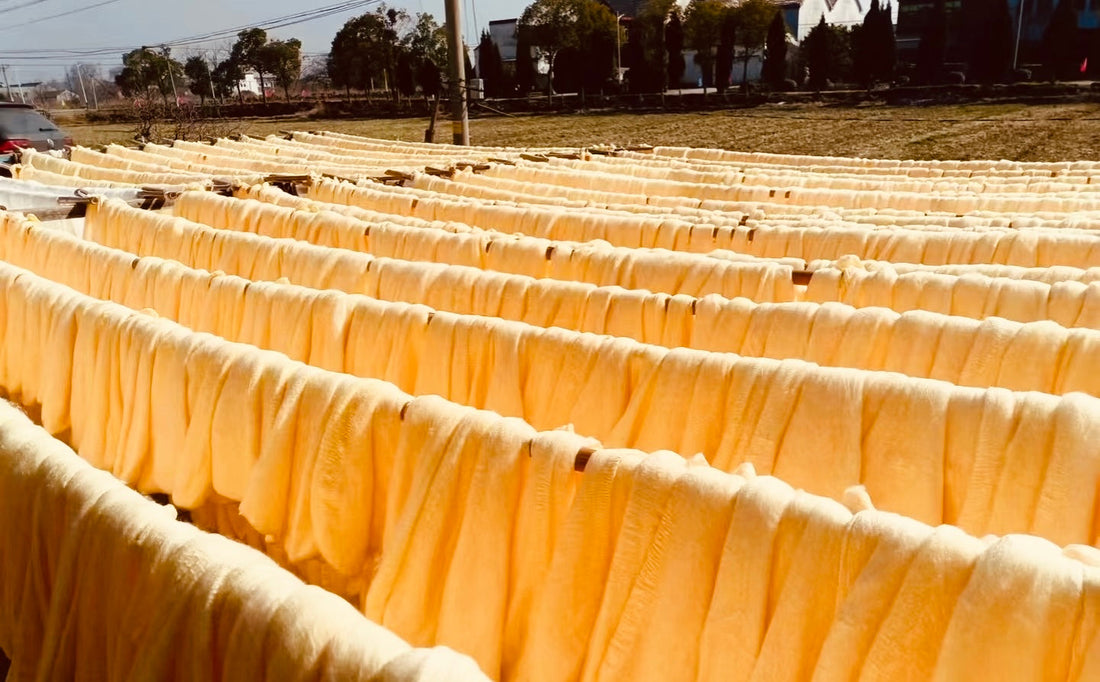
What Is Mulberry Silk? A Guide to the Most Luxurious Fiber in Fashion
Mulberry silk is often hailed as the gold standard of silk, known for its softness, strength, and natural sheen. But what exactly is it—and why do garments made from it come with a premium price tag?
This article breaks down everything you need to know about mulberry silk, from what makes it special to how to care for it, and why it’s such a coveted fiber in the fashion world.
What Is Mulberry Silk?
Mulberry silk is a natural protein fiber produced by the Bombyx mori silkworm, which feeds exclusively on mulberry leaves.
The result is a pure, long, and smooth filament that’s incredibly fine and soft to the touch. This type of silk has been cultivated for thousands of years, most notably in China, and is considered the highest quality silk available.

Why Is Mulberry Silk So Expensive?
Producing mulberry silk is labor-intensive and time-consuming.
Each cocoon must be harvested by hand and carefully unwound to preserve the integrity of the fiber. It takes about 2,500 silkworms to make one pound of silk. The controlled diet and environment of the silkworms also play a major role in the consistency and quality of the fiber. This meticulous process results in a luxurious fabric that commands a higher price.
Mulberry Silk vs. Silk: What’s the Difference?
Technically, all silk comes from insect secretions, but not all silk is mulberry silk. "Silk" is a general term that can refer to wild silk, tussah silk, and other less refined variants. Mulberry silk is a specific type known for its longer fibers, smoother texture, and white color, which allows for vibrant dyeing.
In contrast, other silks might have shorter fibers, uneven textures, and natural tan hues.
Are the Materials and Weaving Methods the Same?
Not quite.
Mulberry silk is often used in finer weaves like charmeuse, habotai, and chiffon. These require high thread counts and specialized looms. The weaving methods for mulberry silk aim to enhance its natural drape and shine, whereas other silks may be used for more textured or rustic finishes.
What Types of Garments Use Mulberry Silk?
You’ll often find mulberry silk in:
- Blouses and shirts
- Pajamas and sleepwear
- Dresses and skirts
- Linings for suits and jackets
- Scarves and accessories
It’s especially popular in summer collections and loungewear due to its breathability and luxurious feel.
Why Does Mulberry Silk Snag So Easily?
Mulberry silk has a smooth, delicate surface that can easily catch on rough skin, fingernails, or textured fabrics. Its tightly woven fibers make it prone to pulls and snags if not handled with care.
How Do You Care for Mulberry Silk?
Treat your mulberry silk with the same respect you would give to a fine cashmere sweater. Here’s how:
- Hand wash in cold water with a silk-safe detergent.
- Avoid soaking for too long—5 minutes is enough.
- Don’t wring or twist. Gently press out the water using a towel.
- Dry flat or hang in a shaded area. Avoid direct sunlight.
- Iron on low heat inside-out, ideally while still slightly damp.
Bonus tip: store your silk garments in a breathable cotton bag to protect them from moths and reduce friction.
What’s a Comfortable Ratio for Silk Blends?
Pure silk is luxurious, but blending it with other fibers can enhance both its comfort and performance. A common and comfortable blend ratio is anywhere from 20% to 40% mulberry silk, mixed with synthetic or plant-based fibers like:
- Nylon (Polyamide): Adds durability and a slight cooling effect. Great for performancewear.
- Polyester: Boosts wrinkle resistance and wicking capabilities. The resulting fabric feels breathable and is easier to care for.
- Cotton: Balances softness and structure. Ideal for shirts and sleepwear.
The right blend can amplify silk’s signature properties—softness, breathability, and thermoregulation—while reducing some of its weaknesses like wrinkling or snagging. It also helps lower costs while still retaining a luxurious feel.
Is It Hard to Weave With Mulberry Silk?
Yes. Because mulberry silk is so fine and smooth, it requires specialized looms and highly skilled technicians to prevent thread breakage and ensure consistent tension. Any errors in weaving can ruin an entire batch. As a result, mills working with mulberry silk typically operate under stricter quality control and slower production speeds.
What Does Mulberry Silk Feel Like to Wear?
Imagine the feel of water gliding over skin—light, cool, and uninterrupted. That’s mulberry silk. It’s incredibly breathable, hypoallergenic, and gentle against the skin. Blended versions offer a bit more structure and stretch, depending on the fiber used.
Why Isn’t Mulberry Silk More Common in Clothing?
Due to cost and handling complexity, most mass-market brands avoid using high percentages of mulberry silk. It's more commonly found in designer labels or high-end basics. Additionally, its delicate nature can be a barrier for consumers who want easy-care garments.
How to Shop for Mulberry Silk
- Look for clarity in product labeling. It should say "100% mulberry silk" or indicate a blend.
- Check the momme count—19 to 25 is a good range for garments.
- Feel the fabric—real mulberry silk feels smooth, not slippery, and has a subtle sheen.
- Beware of vague terms like "silky" or “silk-like” in fast fashion.
Does the Origin Matter?
Yes. China remains the world’s top producer of mulberry silk, especially in Suzhou and Hangzhou. These regions are known for heritage weaving techniques and consistent quality.
Other emerging sources include India and Vietnam, but quality can vary.
Brands That Use Mulberry Silk
Some reputable names include:
- Lunya – silk sleepwear with a modern edge
- Lilysilk – offers silk shirts, pillowcases, and loungewear
- Everlane – occasional silk basics in their Clean Silk line
Bottom line? Mulberry silk is worth the hype—especially if you understand how to care for it and how it compares to other fibers. Whether pure or blended, it remains one of fashion’s finest materials.
Want to dive deeper into silk care?
👉 Read our full guide on how to wash silk without ruining it
Or discover the T-shirt that brings silk-like comfort to performance wear:

